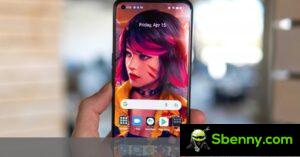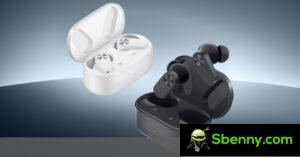Both Google and Apple have made significant generational improvements to their top-of-the-line models this year. The changes to the build and physical properties join the usual upgrades in the camera department and a mandatory update to the interior. But with both the Pixel 8 Pro and iPhone 15 Pro Max improving on their predecessors, which of the new models is better for you?
For starters, you can compare the full spec sheets here or continue directly with our editor’s rating below.
Size comparison
Starting with the Pixel, the 8 Pro is roughly the same size and weight as the 7 Pro. A few things Have have changed, however, and these include the switch from a glossy glass back to a frosted one, as well as the adoption of a flat front compared to the curved panel of the last generation.
The new iPhone 15 Pro Max also arrives with its share of subtle changes, including the switch from stainless steel to an aluminum/titanium build. The new titanium frames are now matte instead of shiny and are slightly rounded at the edges. The display glass also has minimal curvature towards the periphery: it is still flat for the purpose of screen protection, but the new design makes it more refined to the touch and, above all, it is lighter and easier to use than previous Pros Max.
Both phones are quite large, but the Pixel is a little bigger, judging by the numbers: almost 3mm taller and 0.5mm thicker than the iPhone. That said, the Pro Max’s boxier styling leaves the impression of a larger phone. The iPhone is also slightly heavier, but you’ll hardly notice the 8g difference: last year’s 14 Pro Max would have been tangibly heavier than the Pixel.
![]()
Both Google and Apple rely on protective layers made by Corning, but the Pixel 8 Pro is covered by Gorilla Glass Victus 2 on both sides, while the iPhone 15 Pro Max has an Apple-exclusive ceramic shield on the front and a type of glass not specified on the front. Backwards. Both models have an IP68 rating for protection against dust and water, but the iPhone has been tested up to 6 meters underwater, while the Pixel only covers the standard requirements of 1.5 metres.
![]()
Neither model is available in particularly exciting colors, with the exception of the Pixel 8 Pro’s Bay option (a sky blue shade).
Overall, we’d say the iPhone 15 Pro manages to convey a more “premium” presence than the Pixel 8 Pro. That said, the Pixel has gotten a bit more refined this year, and we’re also really digging its color scheme. hero.
View the comparison
At this level it’s understandable that both phones have spectacular displays, and indeed they do. As for the iPhone 15 Pro Max, not much has changed from last year, but the 14 Pro Max was already so far ahead of the curve that no further effort was needed this year. The Pixel 8 Pro, on the other hand, makes significant improvements in brightness over the 7 Pro and possibly refresh rate management.
Somewhat surprisingly, the Pixel 8 Pro fared well 954nits when you turn the brightness slider all the way up, among the second highest numbers we’ve seen outside of auto-brightness modes. The iPhone 15 Pro Max is next in line 846nits – still excellent, of course, just not that high.
The 15 Pro Max regains the lead when you enable adaptive mode: we got it 1,787 nits for the iPhone here, and ‘simply’ 1,600 nits for Pixel 8 Pro.
The iPhone has a small advantage in color calibration, but both are near perfect when viewing sRGB content in the right mode. The iPhone offers support for Dolby Vision, in addition to the HDR10 and HDR10+ standards that Pixel complies with.
A new addition to Android, starting with the Pixel 8 family, is the HDR effect you get in gallery and compatible apps for content that have the metadata to enable it—OLED iPhones have been doing this for years.
Both phones have adaptive refresh rate implementations that allow them to continuously vary the refresh rate to find the best balance between a smooth user experience and battery efficiency. On the Pixel 8 Pro we finally saw a 1Hz reading (the 7 Pro could supposedly go down to 10Hz, but we’ve never seen it dip below 60Hz), while we’ll have to take Apple’s word for it that the 15 Pro Max does 1Hz. Subjectively, both devices offer a remarkably smooth experience.
Battery life
This year the Pixel 8 Pro got a 1% increase in battery capacity and its number now stands at 5,050 mAh. The iPhone 15 Pro Max, on the other hand, has been treated to a much larger 2.7% upgrade and now features a 4,441 mAh cell. Seriously, both abilities are essentially unchanged.
When it comes to endurance, battery capacity is only part of the equation, and our test results demonstrate that the combined effects of the other variables have a more significant impact. That is to say, the iPhone 15 Pro Max lasts significantly longer than the Pixel 8 Pro in both of our screen-on tests, ultimately recording much better overall results in terms of longevity.
Charging speed
The Pixel 8 Pro rehabilitates itself a bit in charging speed, even if it is certainly not a record holder. The Google Phone takes about 26 minutes less to reach a 100% state of charge, although the intermediate results aren’t much better. However, 53% in half an hour seems better than the iPhone’s 46%.
Mind you, the maximum power for both phones is a bit iffy, depending on how you interpret the fine print in the manufacturer’s specs. In any case, the Pixel should fill up faster.
Both phones support wireless charging, with Google specifying a maximum output of 23W with the Google Pixel Stand, while the iPhone maxes out at 15W when using the proprietary MagSafe puck. Using generic Qi-compliant pads will mean 12W max on the Pixel (if the pad itself supports the extended power profile) and 7.5W on the iPhone.
Test the speakers
Both phones feature hybrid stereo speaker setups where the earpiece is also an additional speaker that forms a stereo pair with the “dedicated” speaker on the opposite end of the handset. We got a slightly lower score for loudness on the Pixel than we got on the iPhone, and we also give the Pro Max a nod for output quality, but it’s a hair-splitting exercise: These are some of the best-sounding phones on the market.
You can compare the sound of the two phones under controlled acoustic conditions with the samples below. Just make sure you have headphones on and the volume is turned up.
Performance
The iPhone 15 Pro Max is powered by the custom Apple-designed A17 Pro chipset, which is, unsurprisingly, the best yet. Google also started incorporating its own SoCs a couple of years ago, and the Pixel 8 Pro uses the Tensor G3 chip. Comparing performance between the two is difficult on many levels, starting with the fact that the two phones run on different operating systems, but also because of Google’s continued focus on “optimization” over raw results (although “optimization” is also a buzzword in the world of smartphones). Apple universe, it’s true).
What’s easier to side by side are the memory configurations, and this is where we have a problem with the Pixel 8 Pro having a 128GB base storage version: Apple has finally figured out that the Pro Max should start with 256GB this year. year and Google should have it too. Both phones can be sized up to 1TB though, so there’s parity in that regard. The Pixel comes with 12GB of RAM compared to the iPhone’s 8GB, but the OS specs make this difference moot.
We ran the usual benchmarks on both devices, and the Pixel actually trails the iPhone in these tests. On the other hand, Pixel is also behind other Androids in these same benchmarks.
A little more significant is the comparison under sustained loads, where the iPhone, itself not particularly solid, fares better than the Pixel. We achieved a stability score of 70% versus 62% in the GPU-focused 3DMark Wild Life stress test, and around 78% versus 53% in the CPU stress tests (albeit using different benchmarks on the two platforms).
Google
Pixel 8Pro
AnTuTu 10
1,151,243
Geekbench 6
1,766 single-core
Geekbench 6
4,492 multicores
Neither phone will keep you waiting in real-world use, of course, and both feel really smooth and responsive in real-life operation.
When it comes to long-term software support, Apple has been the gold standard, typically offering 5 years of major OS updates. This year, however, Google promised that the Pixel 8 family will receive 7 years of software support – making promises isn’t quite the same as keeping them, but the Pixel 8 Pro could still receive new software when the 15 Pro Max no longer does.
Camera comparison
The Pixel 8 Pro and iPhone 15 Pro Max are both expert cameraphones, and you can count on their all-round greatness, whether it’s photos or videos that are most important to you. The two also have mostly the same camera systems, each consisting of a primary module with a large sensor, an ultrawide with autofocus, and a telephoto lens that offers 5x zoom. That said, there are subtle differences in how the two capture the world.
Photographic quality
The Pixel has the most vibrant color reproduction, alongside the iPhone’s typically more reserved output in terms of saturation. Pixels tend to have a slight bias towards cooler tones, while the iPhone can be a little warmer, at least this year. Overall, though, it’s largely a matter of preference which “look” is better, and there’s no truly right way to do it.
As for sharpness, there is probably a little more objective distinction, but even then the differences remain minimal. We’d give preference to the Pixel’s ultrawide, while the iPhone’s main camera has perhaps only a small advantage, partly thanks to its 24MP mode. At the 2x zoom level, where both phones harness an extra layer of computational wizardry, we’re getting equally excellent results, perhaps with slightly better definition than the Pixel. Comparing telephoto lenses, we see more or less the same sharpness and detail, but the Pixel has an advantage in terms of noise performance.
![]()
![]()
![]()
![]()
![]()
![]()
![]()
![]()
Daylight examples, Pixel 8 Pro: 0.5x • 1x • 2x • 5x
![]()
![]()
![]()
![]()
![]()
![]()
![]()
![]()
Daylight samples, iPhone 15 Pro Max: 0.5x • 1x • 2x • 5x
In low light conditions, the balance does not change radically, although some further differences in the approach are highlighted. Of note is the more conservative implementation of the iPhone’s Night Mode: It’s less eager to kick into action, and even when it does, it doesn’t liven up images as much as we’d like. The Pixel’s shadows get brighter and reveal more detail – it’s especially noticeable in darker scenes in general, and even more so in those captured with ultrawide.
The iPhone tends to perform better when zoomed in thanks to a more relaxed approach to noise reduction: the Pixel erases some detail along with the noise, the iPhone keeps both, and we like that better. These observations hold true for both the 2x zoom results from the main cameras and the 5x shots from the telephoto lenses.
![]()
![]()
![]()
![]()
![]()
![]()
![]()
![]()
Low-light samples, Pixel 8 Pro: 0.5x • 1x • 2x • 5x
![]()
![]()
![]()
![]()
![]()
![]()
![]()
![]()
Low-light samples, iPhone 15 Pro Max: 0.5x • 1x • 2x • 5x
Video recording
The iPhone has a long-standing reputation for being the go-to smartphone for video recording and the 15 Pro Max is, in fact, a very capable tool for this. But even in this case, the Pixel is no different. Both phones will happily capture video at up to 4K60 across all their cameras, with the less common 24fps also available, alongside the ‘default’ 30fps.
The Pixel has a small edge in sharpness on its ultrawide and less edge at 1x, but the iPhone’s 2x footage is much better. At 5x it’s more of a choice between the two when it comes to details.
The iPhone tends to be more consistent in color reproduction between zoom levels, while the Pixel’s ultrawide veers off track a bit – not much, but it gets warmer than ideal.
![]()
![]()
![]()
![]()
Screenshots, 4K video in daylight, Pixel 8 Pro: 0.5x • 1x • 2x • 5x
![]()
![]()
![]()
![]()
Screenshots, 4K video in daylight, iPhone 15 Pro Max: 0.5x • 1x • 2x • 5x
In low light conditions, often the first thing you see are imperfections in the lenses. The iPhone’s primary is particularly bad in terms of ghosting and internal flare, while the Pixel’s primary camera is a little better at controlling it, though hardly flawless. The Pixel’s telephoto lens, on the other hand, suffers greatly from both ghosting and astigmatism – the heavy ghosting on the iPhone’s 5x camera isn’t that bad yet. In general, you don’t want lights pointing directly at those cameras.
Aside from these things, both phones return footage of fairly similar quality. The ultrawide clips have a comparable level of detail to those shot at 1x and 2x, with perhaps the Pixel’s results being slightly sharper (or more strongly sharpened – one or the other). The iPhone is slightly better at 5x though.
Where the iPhone is superior across the board is dynamic range: it does a noticeably better job of containing highlights than the Pixel.
![]()
![]()
![]()
![]()
Screenshots, 4K video in low light, Pixel 8 Pro: 0.5x • 1x • 2x • 5x
![]()
![]()
![]()
![]()
Screenshots, 4K video in low light, iPhone 15 Pro Max: 0.5x • 1x • 2x • 5x
Both phones have excellent video stabilization. That said, we’d be inclined to give the iPhone a nod here, for its smoother handling of more extreme situations like running and more stable telephoto results.
Here’s a glimpse of how the Pixel 8 Pro’s main camera compares in image quality to that of the iPhone 15 Pro Max in our photo comparison tool.
And here’s how the video quality of the Pixel 8 Pro’s main camera compares to that of the iPhone 15 Pro Max in our video comparison tool.
Verdict
As is often the case when comparing something against an iPhone, the verdict rarely comes down to testing results or performance in this or that field. If you’re an iPhone guy, you’ll probably choose the iPhone, while if you hate the iPhone, you’ll probably look the other way. This year, more than ever, there are fewer differences that can influence this decision, even for those who make it Candies look across the divide between iOS and Android.
![]()
The iPhone 15 Pro Max (left) next to the Pixel 8 Pro
The iPhone’s battery life is better and its chipset is more powerful than the Pixel’s; it’s hard to argue with that. The Pixel’s slightly faster charging doesn’t quite make up for the first point, but we can think of a couple of rather subjective Pixel wins as well: one is for the one exciting colorway between the two phones, and the other is for overall color The Pixel’s most universally likable photographic output.
A more tangible advantage of the Pixel 8 Pro is the price. It costs $200/€350 less than an iPhone 15 Pro Max for versions with basic storage. Even if you choose a 256GB storage version on the Pixel to match the base Pro Max, you’ll still save around $150/€300, not to mention that Pixels are known to be discounted a few months later, unlike I Apple products.
With the two phones practically tied in most areas (and both essentially excellent), the Pixel is easily the better offering. That is, if you haven’t already made up your mind at the juncture between iOS and Android, which most of you probably have.
- The most Android experience.
- The Bay color option.
- The lowest price.
- The most expressive photos.
Get Google Pixel 8 Pro for:
- The Apple ecosystem.
- The best battery life.
- The highest raw performance.
- Slightly better video stabilization.







Start a new Thread